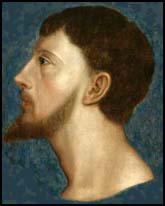Thomas Wyatt

Thomas Wyatt, the eldest son of Thomas Wyatt, the poet, was born in around 1520. He was brought up as a Catholic. He was married at sixteen to Jane Hawte. Through her he acquired the manor of Wavering. Over the next few years she gave birth to ten children.
After the death of his father in 1542 he developed a reputation for wild living. In 1543 Wyatt and his friend, Henry Howard, got drunk and went on a window-breaking spree in London. They were arrested and brought before the privy council on 1st April, and were charged with acts of violence. He remained in the Tower of London until 3rd May.
Wyatt fought under Howard at the Siege of Landrecies in 1544. It was later claimed that Wyatt distinguished himself during the battle. He also took part in the Siege of Boulogne. Howard wrote to Henry VIII highly commended Wyatt's "hardiness, painfulness, circumspection, and natural disposition to the war". He remained in France until the surrender of Boulogne in 1550.
During the final illness of Edward VI, Lady Jane Grey was married to Guildford Dudley, fourth son of John Dudley, Earl of Warwick, as part of the scheme to make sure of a Protestant succession. Jane Grey was declared queen three days after Edward's death. However, she was forced to abdicate nine days later in favour of Edward's sister, Mary Tudor.
Wyatt gave his support to the new queen until he heard she planned to marry Philip of Spain. In January, 1554, he accepted the invitation from Edward Courtenay, to join in a general insurrection throughout the country against the marriage. Based at Rochester Castle, Wyatt soon had fifteen hundred men under his command.
When Mary Tudor heard about Wyatt's actions, she issued a pardon to his followers if they returned to their homes within twenty-four hours. Some of his men took up the offer. However, when large number of the army sent to arrest Wyatt changed sides, he controlled a force of 4,000 men. He now felt strong enough to march on London.
On 1st February, 1554, Mary addressed a meeting in the Guildhall where she proclaimed Wyatt a traitor. The next morning, 20,000 men enrolled their names for the protection of the city. The bridges over the Thames within a distance of fifteen miles were broken down and on 3rd February, a reward of land of the annual value of one hundred pounds a year was offered to the person who captured Wyatt.
By the time Wyatt entered Southwark, large numbers of his army had deserted. However, he continued to march towards St. James's Palace, where Mary Tudor had taken refuge. Wyatt reached Ludgate at two o'clock in the morning of 8th February. The gate was shut against him, and he was unable to break it down. Wyatt now went into retreat but he was captured at Temple Bar.
Wyatt was taken to the Tower of London and on 15th March he was convicted of high treason and sentenced to death. At the scaffold on Tower Hill on 11th April he made a speech claiming that Princess Elizabeth had not been involved in the plot against her sister.
| Spartacus E-Books (Price £0.99 / $1.50) | ||||||
|---|---|---|---|---|---|---|





